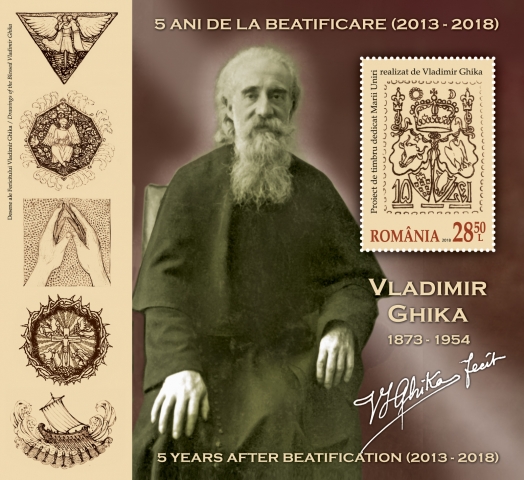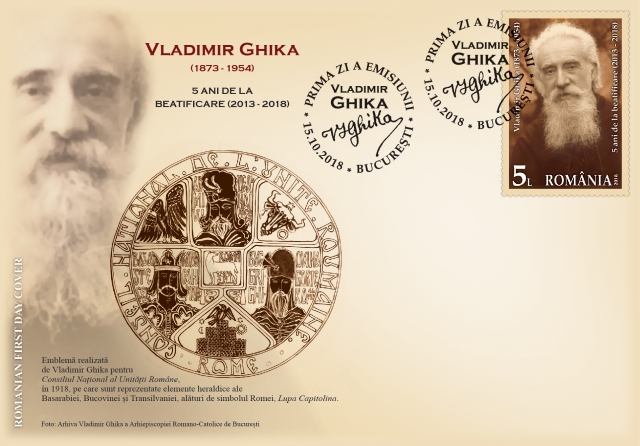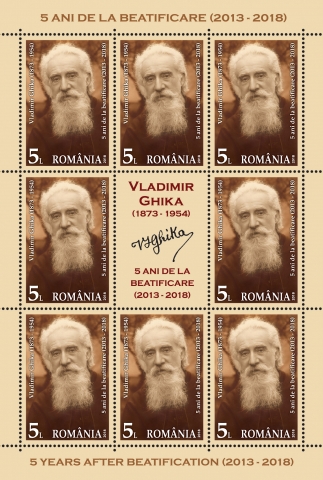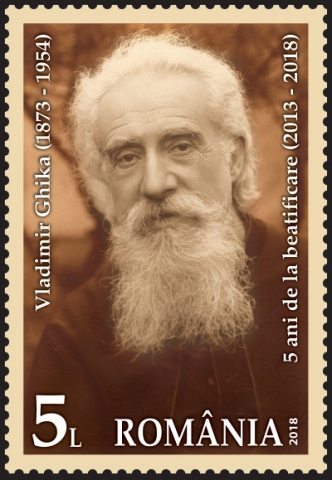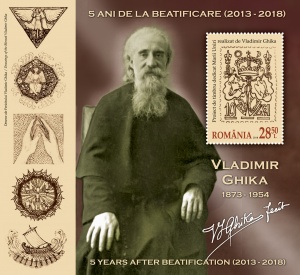 On the occasion of the fifth celebration of the beatification of Monsignor Vladimir Ghika (1873-1954), by the Roman Catholic Church, Romfilatelia introduces into circulation a commemorative postage stamp issue dedicated to the monk-prince’s martyrdom. On the stamp of the issue, with the face value of Lei 5, a portrait of the Blessed Vladimir Ghika, performed during a mission in Japan (1933), is illustrated. On the perforated souvenir sheet of the issue, with the face value of Lei 28.50, another picture of the Blessed was reproduced. The stamp of the souvenir sheet is a postage mark designed by Vladimir Ghika, in 1918, containing heraldic elements of the historical regions of Greater Romania.
On the occasion of the fifth celebration of the beatification of Monsignor Vladimir Ghika (1873-1954), by the Roman Catholic Church, Romfilatelia introduces into circulation a commemorative postage stamp issue dedicated to the monk-prince’s martyrdom. On the stamp of the issue, with the face value of Lei 5, a portrait of the Blessed Vladimir Ghika, performed during a mission in Japan (1933), is illustrated. On the perforated souvenir sheet of the issue, with the face value of Lei 28.50, another picture of the Blessed was reproduced. The stamp of the souvenir sheet is a postage mark designed by Vladimir Ghika, in 1918, containing heraldic elements of the historical regions of Greater Romania.
Vladimir Ghika was born on December 13/25th, 1873, in Constantinople, where his father was on a diplomatic mission. The Ghika family had aristocratic origins, Vladimir being the grandson of Grigore V. Ghika Voda, the last Ruler of Moldavia. The young prince was baptized and oiled in the Orthodox Church, according to the family tradition.
Blessed Vladimir Ghika lived most of his life outside Romania. His intellectual training and education took place in France, where he settled in 1878, after his father, Ion Ghika, had been appointed minister of Romania in Paris. Vladimir Ghika graduated from the high-school, the Law School and the School of Political Science in Toulouse. He was very close to his brother Dimitrie, a career diplomat, whom he followed in all diplomatic missions.
In 1898, Dimitrie was sent by the Romanian Ministry of Foreign Affairs to Rome, an opportunity for Vladimir to come close to Catholicism. He made the profession of Catholic faith at “Saint Sabina” Church in Rome on April 15th, 1902. He later studied at “St. Thomas Aquino” College, obtaining a Bachelor’s degree in scholar philosophy and a Ph.D. degree in Theology. Vladimir Ghika also researched the Vatican archives and transcribed documents of interest to Romania, at the request of the Government of Bucharest.
During the World War I, Vladimir Ghika moved to Rome, along with his brother Dimitrie, who had been named ambassador. Romania did not have an official representation near the Holy See, and by his prolific work, Vladimir Ghika was a kind of ambassador to the Vatican. The two brothers constituted a double embassy of Romania: Dimitrie – the King’s Messenger, Vladimir – the God’s Messenger.
In 1918, the Monsignor participated in the lobbying activities initiated by the National Council of Romanian Unity, based in Paris. On September 28th, 1918, Vladimir Ghika was officially appointed by the Council to represent Romania in relation to the Holy See. In this capacity, he informed the Holy Father the news of the Great National Assembly in Alba Iulia on December 1st, 1918. In Rome to represent the union interests, Vladimir Ghika also made some thematic drawings, including stamp projects containing the heraldic elements of the Romanian historical regions and an emblem of the National Council of Romanian Unity, which was represented symbols of the new regions joined to the Kingdom of Romania, namely Transylvania, Bessarabia and Bukovina. This emblem is on the First Day Cover of the postage stamp issue Vladimir Ghika, 5 years after beatification.
After the war, Vladimir Ghika dedicated his life to the church, having a rich missionary activity, all over the world. Even though he was officially the Pope’s messenger, the locals knew he was a Romanian prince, an association that contributed to the fame of the country.
In 1939, after the outbreak of the World War II, Vladimir Ghika decided to stay in Romania. He served daily the liturgy in his apartment in Dacia Boulevard in Bucharest, and the processions began to be very popular, his dwelling becoming scanty.
After 1945, he continued his missionary activity, which is why he came into conflict with the communist authorities.On November 18th, 1952, Vladimir Ghika was arrested on the street, accused of not interrupting ties with the Vatican. Following the trial, he was sentenced to three years in prison, being imprisoned at Jilava. After a lifetime in the service of God and the nation, Vladimir Ghika passed to the Lord on May 16th, 1954, at the age of 81, in Jilava Prison.
In November 1991, His Eminence Ioan Robu, Metropolitan Archbishop of Bucharest, submitted to Rome the document Nihil obstat, to begin the recognition of the martyrdom of Monsignor Ghika. The beatification of Blessed Vladimir Ghika ended on August 31st, 2013, through an impressive ceremony held in Bucharest.
To celebrate the complex personality of Blessed Vladimir Ghika, the Romanian Academy appointed him a post-mortem member on November 5th, 2013.
Romfilatelia thanks Monsignor Miguel Maury Buendía, Apostolic Nuncio in Romania, His Eminence Ioan Robu, Ph.D. and the Roman Catholic Archdiocese of Bucharest.
The new issue will be available on Monday, October 15th 2018, in Romfilatelia’ own shops network in Bucharest, Bacau, Brașov, Cluj-Napoca, Iași and Timișoara and online on https://romfilatelia.ro/store/. The postage stamp issue is completed by envelope equipped with the postage stamp of the issue, numbered and cancelled with the “first day” postmark . As page composition there were used a sheet of 32 stamps, minisheet of 8 stamps + 1 label and perforated souvenir sheet.
For further information, please contact the Public Relation Office:
Tel: 021 / 337 24 42



